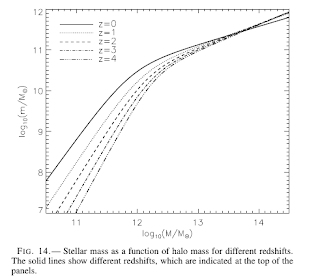Title: Constraints on the relationship between stellar mass and halo mass at low and high redshift
Authors: Moster, Somerville et al.
Year: 2009, http://arxiv.org/abs/0903.4682
They give a nice breakdown of the methods used to link the halo properties with those of the galaxy. It is possible to obtain these relations from observations (kinematics, lensing, X-rays), from bottom-up modelling (N-body or SAMs), or by using a statistical approach: obtaining the probability that a halo with a certain mass hosts a certain number of galaxies with some certain properties (luminosity, type, etc.). This way, we don't have to make assumptions about feedback and other poorly-understood processes that plague the SAMs. I'll review the lecture recordings from Jerusalem School, I think the formalism used was explained in detail there.
The goal of this paper is to construct the conditional stellar mass function (as opposed to the conditional luminosity function). Such a function provides the average number of galaxies in a certain stellar mass range that reside in a halo with a mass M -- it can also be viewed as the stellar mass function for the haloes of mass M.
They use a N-body simulation to obtain a population of DM haloes and their merger tree information. The ratio of the halo mass M and the stellar mass M is not constant (due to different feedback processes), so they use a parameterisation of it to fill the haloes with galaxies, and obtain the stellar mass-Mhalo relation.
In order to obtain the conditional mass function, they divide the galaxies into centrals and satellites, parameterising their distribution in two different ways. The total CMF is the combination of the two.
They also obtain the M* -- M_halo relationship for higher redshifts, claiming that 'large halos accrete dark matter faster than large galaxies grow in stellar mass, while the growth of low mass halos is slower than that of the central galaxies they harbor', (see the attached picture).

This paper does not mention the TF relation, however, I wanted to find out more about the M*-Mhalo relation, the ways to determine it and its evolution. It's interesting that the high-mass end of this relation does not evolve much since z=4.
Authors: Moster, Somerville et al.
Year: 2009, http://arxiv.org/abs/0903.4682
They give a nice breakdown of the methods used to link the halo properties with those of the galaxy. It is possible to obtain these relations from observations (kinematics, lensing, X-rays), from bottom-up modelling (N-body or SAMs), or by using a statistical approach: obtaining the probability that a halo with a certain mass hosts a certain number of galaxies with some certain properties (luminosity, type, etc.). This way, we don't have to make assumptions about feedback and other poorly-understood processes that plague the SAMs. I'll review the lecture recordings from Jerusalem School, I think the formalism used was explained in detail there.
The goal of this paper is to construct the conditional stellar mass function (as opposed to the conditional luminosity function). Such a function provides the average number of galaxies in a certain stellar mass range that reside in a halo with a mass M -- it can also be viewed as the stellar mass function for the haloes of mass M.
They use a N-body simulation to obtain a population of DM haloes and their merger tree information. The ratio of the halo mass M and the stellar mass M is not constant (due to different feedback processes), so they use a parameterisation of it to fill the haloes with galaxies, and obtain the stellar mass-Mhalo relation.
In order to obtain the conditional mass function, they divide the galaxies into centrals and satellites, parameterising their distribution in two different ways. The total CMF is the combination of the two.
They also obtain the M* -- M_halo relationship for higher redshifts, claiming that 'large halos accrete dark matter faster than large galaxies grow in stellar mass, while the growth of low mass halos is slower than that of the central galaxies they harbor', (see the attached picture).

This paper does not mention the TF relation, however, I wanted to find out more about the M*-Mhalo relation, the ways to determine it and its evolution. It's interesting that the high-mass end of this relation does not evolve much since z=4.
No comments:
Post a Comment